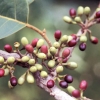Cinnamon Essential Oil Shows In Vitro Cytotoxicity
 The essential oil from the bark of Cinnamomum zeylanicum Blume (cinnamon) was analyzed by GC-MS and bioassays were carried out. Nine constituents representing 99.24% of the oil were identified by GC-MS. The major compounds in the oil were (E)-cinnamaldehyde (68.95%), benzaldehyde (9.94%) and (E)-cinnamyl acetate (7.44%).
The essential oil from the bark of Cinnamomum zeylanicum Blume (cinnamon) was analyzed by GC-MS and bioassays were carried out. Nine constituents representing 99.24% of the oil were identified by GC-MS. The major compounds in the oil were (E)-cinnamaldehyde (68.95%), benzaldehyde (9.94%) and (E)-cinnamyl acetate (7.44%).
The antimicrobial activity of the essential oil was investigated in order to evaluate its efficacy against twenty-one bacteria and four Candida species, using disc diffusion and minimum inhibitory concentration methods.
Cinnamon essential oil showed strong antimicrobial activity against all microorganisms tested. The cytotoxic and apoptotic effects of the essential oil on ras active (5RP7) and normal (F2408) fibroblasts were examined by MTT assay and acridine orange/ethidium bromide staining, respectively.
The cytotoxicity of the oil was quite strong with IC(50) values less than 20 μg/mL for both cell lines. 5RP7 cells were affected stronger than normal cells. Morphological observation of apoptotic cells indicated the induction of apoptosis at the high level of the oil, especially in 5RP7 cells.
The present study showed the potential antimicrobial and anticarcinogenic properties of the essential oil of cinnamon bark, indicating the possibilities of its potential use in the formula of natural remedies for the topical treatment of infections and neoplasms.
Copyright © 2010 Mehmet Unlu, Emel Ergene, Gulhan Vardar Unlu, Hulya Sivas Zeytinoglu, Nilufer Vural; Department of Microbiology, Faculty of Medicine, Cumhuriyet University, 58140 Sivas, Turkey.






























